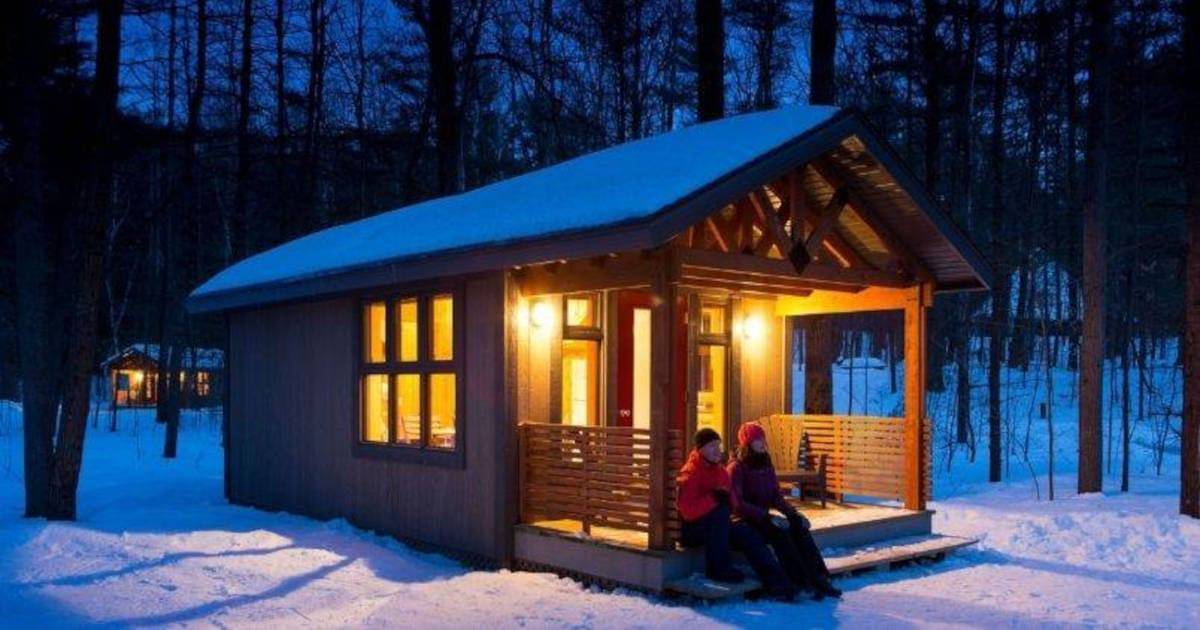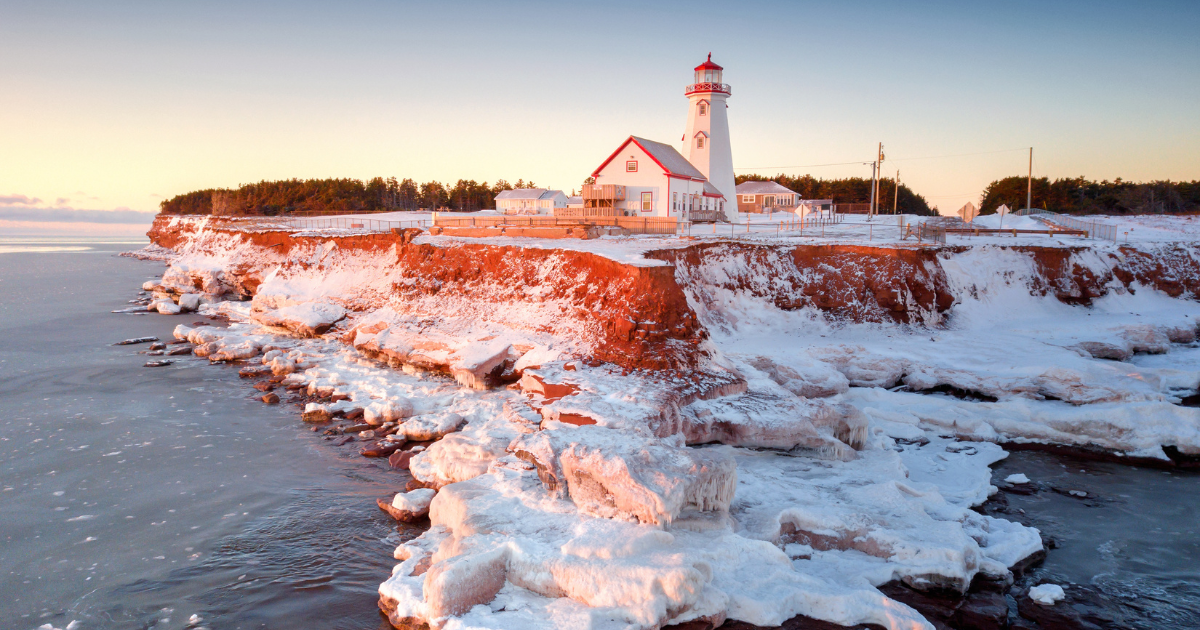Living in one of the most diverse and beautiful countries in the world has a huge drawback, one I’m sure many Canadians will recognize: the seemingly endless winters. However, there is much beauty to behold in the colder months, even when hidden under a thick blanket of snow. The landscape transforms completely, and if you’re planning on hibernating for the winter, you’re missing out on some truly incredible experiences. Camping, popular when temperatures are soaring and the sun sits high up in a clear blue sky, is equally wonderful when done in the winter. And there’s a bonus: no bugs!
Here are some amazing camping destinations across Canada to check out this winter.
Strathcona Provincial Park, Vancouver Island, British Columbia
Located on Vancouver Island, Strathcona Provincial Park is a good entry point for beginner winter campers. The temperatures are usually milder in this part of Canada, making it a great family-friendly option. Set up camp at the Forbidden Plateau (in the Strathcona backcountry), available year-round by permit, or at the Circlet Lake Campground, which has 20 wooden platforms for you to set your tent on that can be booked at the Paradise Meadows Trailhead at the Backcountry Camping Fee Station. There are numerous hiking trails offering stunning vistas, but be sure to visit Cruikshank Canyon for unforgettable views, as well as nearby Lake Beautiful, which lives up to its name, even in winter. Head over to Campbell River to see the beautiful wooden sculptures, pieces created at the Transformations on the Shore event (held every year at the end of June) and strewn throughout the many trails around that area. Rent snowshoes at Mount Washington and traverse the alpine trails, or ski the beautiful snow-covered terrain at Mount Washington Alpine Resort (also a great option if you’re not too keen on pitching a tent in the snowy wilderness). Remember to bring your hiking poles! They’ll come in handy for travelling through deep snow. discovercamping.ca/backcountry
Garibaldi Provincial Park, British Columbia
About 70 km north of Vancouver, Mount Garibaldi is a big attraction, with its striking turquoise lake, postcard-worthy peaks and breathtaking views. Visiting the park during the quieter winter months gives you the chance to explore its many trails and take in the local wildlife more peacefully. There are campgrounds throughout the park, and plenty of opportunities for skiing, snowshoeing and snowboarding, but these are best suited to visitors with experience in extreme weather conditions. Because of the amount of snow Garibaldi receives each year, skis and snowshoes are required for winter travel throughout the park. During winter months, there is also a risk of avalanche in the backcountry, so check weather conditions before planning your trip. Garibaldi is as beautiful as it is dangerous, but with the right information, preparation and experience, its lake, forests and snow-capped peaks offer an unforgettable experience. gov.bc.ca/bcparks
Glacier National Park of Canada, British Columbia
Known for its prodigious snowfall, Glacier National Park of Canada is a popular destination for ski lovers the world over. The park offers ski trails for more experienced skiers, but if you’re just out for the winter-camping experience, permits are available for backcountry campers. Winter camping at Hermit, Mount Sir Donald and Bald Hills Wilderness Hiking Route is permitted, where tent pads, food storage poles and food lockers are supplied to help protect you from bears. The Rogers Pass Discovery Centre, open year-round and a replica of a historic railway snowshed, should be your first stop before hitting the Rogers Pass National Historic Site, where you can hike along the abandoned Canadian Pacific Railway (preferably by ski or snowshoe!). Create fresh trails through untouched powder, and take in the wide open views. You’ll find glaciers and waterfalls frozen mid-fall in the Asulkan Valley, and you can forest-bathe through old-growth forests along the Hemlock Grove Boardwalk. If you feel like going on a social media adventure, you can search for the 18 red Muskoka chairs located throughout the park and tag your picture #ShareTheChair to share your view of the stunning nature at Glacier National Park of Canada. pc.gc.ca
Dinosaur Provincial Park, Alberta
Winter camping may seem exhilarating enough, but imagine camping on top of undiscovered fossils or the dinosaur bones that put Alberta’s Dinosaur Provincial Park on the map! Designated a UNESCO World Heritage Site in 1979, the park is where more than 400 dinosaur skeletons have been unearthed, representing 55 different dinosaur species. In addition to visiting the park, you can rent a campsite here to max out your stay. There are only 65 winter campsites available at the Dinosaur Campground (open year-round), with limited amenities (no flush toilets or water, so come prepared). Although the excursions are not available during the winter months, you can still explore parts of the park on your own, or just enjoy walking in the footsteps of dinosaurs. Winter is a quieter time of year to visit, and you can still experience the five self-guided trails (open year-round), most notably the Badlands Trail, which takes you through a landscape of sandstone ridges and hoodoos (unique pillar-like rock formations), and the Trail of the Fossil Hunter, which ends at the 1913 quarry, where many fossils were excavated. You’ll also find plenty of birds, deer and owls here too. albertaparks.ca
Writing-on-Stone Provincial Park, Milk River, Alberta
Writing-on-Stone Provincial Park is home to hundreds of First Nations pictographs and petroglyphs, some dating back 5,000 years. It’s a deeply sacred space specific to the local Blackfoot First Nations, whose stories, culture and history are depicted on the rock walls. The Blackfoot believe that the area is charged with spirits who have the ability to help those who pray here. Book one of the 61 campsites available in the winter on a first-come, first-served basis here, or contact the Alberta Parks Contact Centre (1-877-537-2757 toll-free) to book in advance. Power is available year-round, but water is not, so bring your own. A few notable experiences are the Hoodoo Trail, a fascinating hike through an otherworldly landscape of hoodoos and hills; the beautiful Milk River; and the Battle Scene Trail, which will lead you to the detailed battle scene petroglyph, thought to be carved in the late 1880s. The snow doesn’t get very deep here, so you can snowshoe or hike the trails with ease. Come prepared for cold weather, though, as temperatures typically dip to –11°C. It’s a strangely beautiful place in any season, and a fascinating link to our history. albertaparks.ca
MacGregor Point Provincial Park, Lake Huron, Ontario
Set on the shores of the turquoise-tinged Lake Huron, MacGregor Point is a veritable winter wonderland with tons of fun outdoor activities the whole family can enjoy. The star of the show, however, might well be the popular and very Instagrammable 400-metre skating oval, which takes you through forest and is lit up at night. Pay a daily vehicle fee to enter the park and set up your winter tent at one of the designated campsites. With a heated comfort station, you may not feel like you’re really braving the cold until you’re sleeping under the stars on your insulated foam mat. You can ski the Deer Run Trail, snowshoe the Old Shore Road Trail, or hike up to Sunset Point to take in a majestic view of Lake Huron. Bring your own snowmobile and enjoy a ride on the park roads or the West Trail of Brant Park, or book a snowmobiling tour through snowmobilegreybruce.com, where you can also rent a snowmobile. ontarioparks.com
Algonquin Provincial Park, Ontario
With its proximity to Toronto, Algonquin Park is a popular camping spot in both winter and summer. Although lodges are not available in winter, you can rent a yurt or set up a tent at Mew Lake Campground, or if you’re feeling adventurous, camp in the backcountry, where campsites are accessible by ski or snowshoe only. (Camping permits can be purchased at the park’s east and west gates year-round.) Once your campsite is set up, take your pick of winter activities: skiing on one of the many trails suitable for beginner to novice skiers, snowshoeing on the Old Railway Trail, skating on the frozen Kawawamog Lake or hiking Hemlock Bluff and the Big Pines Trail, where you can visit old-growth white pines. There’s even dogsledding and ice fishing. With all these outdoor winter activities on offer, you won’t have a chance to feel the cold because you’ll be too busy working up a sweat. History buffs will also want to check out the outdoor exhibits at the Algonquin Logging Museum and the 1880s logging camp. ontarioparks.com
Oka National Park, Quebec
Oka has stunning forests and trails with varying degrees of difficulty, all open during the winter camping season. The parks are administered by Sepaq (which stands for Société des établissements de plein air du Québec), which manages the province’s national parks and wildlife reserves. Only about a 45-minute drive from Montreal, Oka National Park’s proximity to the city means that it is usually busy in the summer, so winter is a great time to visit if you want to avoid the crowds. Catch your dinner at an ice-fishing hole, snowmobile back to your campsite and cook over an open fire. You can go on a dogsledding trip, or snowshoe on one of the trails. If you’re into exploring some of the historical monuments in the area, take the Oka Cavalry Trail, which will bring you to a series of seven chapels and shrines built in the 1740s, representing the Catholic Stations of the Cross. Book a “rustic” campsite through Sepaq and set up a tent surrounded by the trees. There are now also 10 compact cabins available to rent year-round in Le Meandre (located within Oka), which accommodate up to four people each and offer a respite from the cold. They come with kitchens and showers, so you’ll feel like you’re right at home.
sepaq.com
Fundy National Park, New Brunswick
Known for having the highest tides in the world, the Bay of Fundy is one of North America’s Seven Natural Wonders. Although in winter you won’t get to visit the tides the same way as you would in summer, you can still see the way the water has carved the coastline and created sculptural rock columns and dramatically coloured cliffs, visible in any season. Winter camping is open year-round at the Headquarters Campground, where you can take in scenic views of the Bay of Fundy right from your campsite. Drinking water, heated washrooms and showers, as well as an enclosed kitchen shelter, are all amenities that you can enjoy here during the winter. Take part in classic Canadian winter activities such as skiing, snowboarding, showshoeing and tobogganing over Fundy’s snow-covered landscape or hike through the Acadian forests. The hike to Dickson Falls is worth the effort to see the semi-frozen waterfall. pc.gc.ca
Kluane National Park, Yukon
Awe-inspiring views greet you at Kluane National Park, from the snow-capped peaks of Mount Logan to magnificent glaciers and maybe even a grizzly bear or two. (Hopefully very far off in the distance.) When it comes to camping at Kluane, though, this destination is for seasoned winter campers only. Temperatures drop to –21°C in the middle of winter, so prepare for cold weather. You can reserve a campsite, and backcountry permits are available within the Kluane Icefields. Every winter activity you can think of is available here, including skiing, snowboarding, ice fishing and dogsledding. You can also turn your gaze upward and experience the northern lights. The Yukon Astronomical Society offers a night-sky presentation and public sky gazing on Mondays, so add it to the itinerary if your trip extends past the weekend. Without the light pollution common to bigger cities, you’ll be able to see all of the stars, a few constellations and maybe a falling meteor or two. Come prepared for extreme cold weather, with extra-warm clothing, two sleeping pads and a hot water bottle to keep you warm at night.
pc.gc.ca
What Are Yurt Waiting For?
If you’re not into roughing it but still want to get your share of the winter wild, there are plenty of options that will get you out in nature.
Yurts: Cape Breton, Nova Scotia
Located at parks across the country, yurts offer a comfortable alternative to camping on the ground. The tented, round structure is designed to protect you from the elements and keep you nice and cozy all night long. On Cape Breton Island, you can start your Cabot Trail experience by staying in a traditional Mongolian yurt. It’s one of the most magical places in Canada to visit in any season and should be on your Canadian travel bucket list. Bonus: The Atlantic Ocean is right there. cabotshores.com
Geodesic Domes: P.E.I.
Geodesic domes are sprinkled all around the globe, but these P.E.I. domes make a visit to the island extra special. Become one with nature in one of five geodesic domes in Treetop Haven, available year-round. You’ll feel like a kid again in your very own treehouse, with all of the grown-up luxuries. Domes come with a bed, kitchen, bathroom and deck, so you can feel right at home high up in the trees. treetophaven.ca
Free Spirit Spheres: British Columbia
Free Spirit Spheres give guests a magical experience way up in the trees of British Columbia. The spheres are equipped with thermostats that guests control, so you can heat up your space on a cold day. They are available for bookings throughout the winter. Make yourself a hot chocolate (each sphere has a kettle and snacks) and take in the snow-blanketed forest from the comfort of your gently swaying sphere. freespiritspheres.com
RVing in Winter
RVing in winter is a great way to experience the countryside in a fresh way. Keep in mind, though, that not all roads are traversable in the middle of winter and may not be available at all in avalanche zones, so check the weather and road conditions of the places you wish to travel when planning your trip and before you set out. Most campsites have electrical hookups at designated areas within the campground, but they’re often first come, first serve, so book ahead. When RVing in winter, bring warm quilts and electric blankets for extra warmth, and remember to park your RV in a sunny spot so it can capture heat from the sun. For more tips and ideas on RVing, visit gorving.ca.
Winter Camping Safety
Winter camping is an extraordinary experience, but there are a few things to keep in mind while planning your winter camping excursion. Bring warm clothing, preferably woollen items, which will keep you warm, dry and protected against the elements. Hand and feet warmers for long hikes are a must, and pack extras. Foam pads, preferably two, under your sleeping bag will add additional protection from the cold ground, but also invest in a good-quality sleeping bag to keep you warm through the night. Because water may be hard to come by at your campsite and can be hard to lug around, pack water-treatment products to create drinking water from the snow. Visit MEC’s blog for more winter camping tips and ideas: mec.ca/en/article/winter-camping-tips-26-things-beginners-should-know. or https://www.untamedspace.com/winter-camping/
An editor with 15-plus years in the publishing business, Catalina Margulis’ byline spans travel, food, decor, parenting, fashion, beauty, health and business. When she’s not chasing after her three young children, she can be found painting her home, taming her garden and baking muffins.













